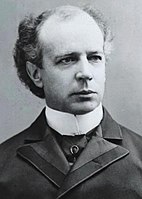
Back Kanadische Unterhauswahl 1896 German Elecciones federales de Canadá de 1896 Spanish Élections fédérales canadiennes de 1896 French הבחירות הפרלמנטריות בקנדה 1896 HE
| |||||||||||||||||||||||||||||||||||||
213 seats in the House of Commons 107 seats needed for a majority | |||||||||||||||||||||||||||||||||||||
|---|---|---|---|---|---|---|---|---|---|---|---|---|---|---|---|---|---|---|---|---|---|---|---|---|---|---|---|---|---|---|---|---|---|---|---|---|---|
| Turnout | 62.9%[1] ( | ||||||||||||||||||||||||||||||||||||
| |||||||||||||||||||||||||||||||||||||
 1896 Canadian electoral map | |||||||||||||||||||||||||||||||||||||
 The Canadian parliament after the 1896 election | |||||||||||||||||||||||||||||||||||||
| |||||||||||||||||||||||||||||||||||||
The 1896 Canadian federal election was held on June 23, 1896, to elect members of the House of Commons of Canada of the 8th Parliament of Canada. Though the Conservative Party, led by Prime Minister Charles Tupper, won a plurality of the popular vote, the Liberal Party, led by Wilfrid Laurier, won the majority of seats (with only 41 percent of the vote) to form the next government. The election ended 18 years of Conservative rule.
This was first election in Canada to produce a House of Commons with elected members of four parties. The Liberals and Conservative shared the chamber with elected members of the farmer-based Patrons of Industry and McCarthyites.
- ^ "Voter Turnout at Federal Elections and Referendums". Elections Canada. Retrieved March 10, 2019.
Cite error: There are <ref group=lower-alpha> tags or {{efn}} templates on this page, but the references will not show without a {{reflist|group=lower-alpha}} template or {{notelist}} template (see the help page).

